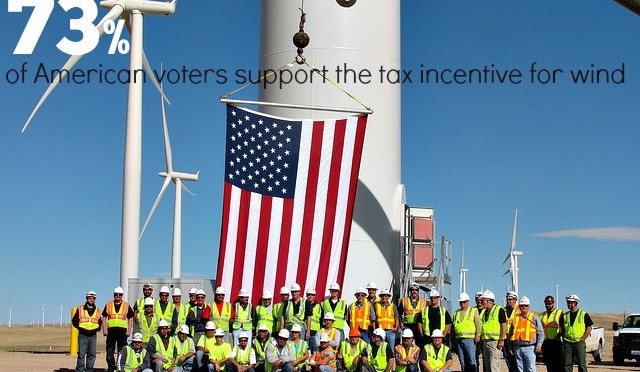Additional key findings of the US wind energy industry third quarter 2019 report include: Strongest third quarter for wind farm installations on record with 1,927 MW newly online; Near-term wind advanced development pipeline reaches record 46.5 GW; Nearly 6,000 MW of offshore wind turbines projects in advanced development.

There
are now more than 100 gigawatts (GW) of wind farms operating across the
U.S., enough to power 32 million American homes, marking a major
milestone in the transition to a cleaner electricity supply. The 100 GW
milestone was first reported in today’s public release of the American
Wind Energy Association’s (AWEA) U.S. Wind Industry Third Quarter 2019
Market Report.
The modern U.S. wind industry was born in
California in the 1980s. Starting from humble beginnings, the industry
started to grow quickly in 2008. At the beginning of that year the
country only had 25 GW of wind power, but in the eleven years since the
industry has delivered an additional 75 GW of clean, affordable power to
American consumers. For context, 100 GW of wind power generates more
electricity than California and New Jersey together consume each year.
“100
gigawatts of wind isn’t just a number, it’s the product of 40 years of
ingenuity and work from the more than 114,000 Americans directly
employed by the wind industry,” said AWEA CEO Tom Kiernan. “Their hard
work has paid off from pioneering California to the booming wind belt in
America’s heartland and our first offshore project in New England
waters. Wind now supplies clean and efficient power to the equivalent of
32 million American homes, sustains 500 U.S. factories, and delivers
more than one billion dollars a year in new revenue to rural communities
and states.”
As wind energy grows across the country, so do its
economic and environmental benefits. Wind strengthens the U.S. economy
by supporting 114,000 jobs, 500 factories, and $1 billion each year in
lease payments to landowners combined with state and local taxes.
Innovation has cut the cost of wind energy by 69 percent in the last
decade, contributing to lower overall electricity costs for American
homes and businesses.
Increasing the use of wind energy also cuts
harmful air pollution and preserves fresh water supplies for drinking
and agriculture. In fact, wind power is one of the most affordable and
rapidly deployable options to address climate change. 100 GW of wind
power avoids greenhouse gas emissions equal to 240 million metric tons
of carbon dioxide each year or roughly 13 percent of yearly U.S. power
sector emissions.
AWEA’s third quarter 2019 report first revealed
the U.S. has reached 100,125 megawatts (MW) of wind energy, with more
than 57,700 wind turbines spinning across 41 states and two U.S.
territories. This milestone was reached as developers installed eight
new wind projects totaling 1,927 MW in the third quarter, the highest
third quarter for installations on record. Installations for the year
total 3,667 MW, a 123 percent increase over the first three quarters of
2018.
Strong wind power deployment is expected to continue. The
near-term wind project pipeline grew to yet another record in the third
quarter of 2019, reaching 46.5 GW – equal to almost half of the wind
energy operating today. There are now 22,651 MW under construction and
an additional 23,844 MW in advanced development, including 5,792 MW of
offshore wind. The total pipeline increased 11 percent over the second
quarter and 22 percent year-over-year as project developers announced
10,090 MW of new projects in the third quarter.
This project
pipeline continues to grow thanks to demand for affordable, reliable,
and clean wind power from utilities and corporate purchasers, as well as
state-driven demand for offshore wind. Project developers and power
purchasers announced 1,379 MW of power purchase agreements (PPA) in the
third quarter of 2019, contributing to a total of 6,179 MW for the year.
Corporate customers including Sprint, Gap, and Honda signed up for 888
MW of wind. Utilities announced plans to build and own 4,198 MW of new
wind projects, including 2,640 MW of offshore wind. States also
continued their push for offshore wind, with New York selecting 1,696 MW
from two projects to help meet its goal of 9,000 MW of offshore wind by
2035, while Virginia Governor Northam issued an Executive Order for the
state to develop 2,500 MW of offshore wind by 2026.
“Wind power
is growing rapidly, especially with a major new market opportunity
offshore,” Kiernan said. “Americans will reap the benefits of the next
100 GW of clean, reliable wind energy in much less time and at lower
cost. As we speak, wind farms with a record combined capacity of over 46
GW are already in the works and expected to come online in the next few
years.”


